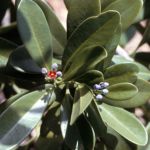| Common Name: |
Canella |
| Other Names: |
White cinnamon, wild cinnamon |
| Botanical Name: |
Canella winterana syn. C. alba |
| Genus: |
Canella |
| Family: |
Canellaceae |
| Native Location: |
West Indies, Florida Keys |
| Cultivation: |
Well-drained, sandy soil in sun. |
| Propagation: |
By ripewood cuttings with a heel in spring. |
| Harvest: |
Leaves are picked and used fresh or dried. Bark is dried in long quills for oil distillation or for use in condiments, decoctions, and tinctures, and as a powder with aloes. |
| Height: |
10-15m (30-50ft) |
| Width: |
7-10m (22-30ft) |
| Hardiness: |
Z10 |
| Parts Used: |
Leaves, bark, oil |
| Properties: |
A bitter, aromatic herb that improves digestion and also have anti-microbial effects. |
| Medicinal Uses: |
Internally for poor digestion. Externally for rheumatic pains (Cuba). Combined with aloes (Aloe vera, see Aloe Vera) for constipation and menstrual problems (West Indies). An aromatic adjunct in prescriptions for treating digestive complaints. |
| Culinary Uses: |
Bark and leaves are used in seasoning mixtures and added to tobacco (West Indies). Bark is used to flavor "clove vodka" in Russia. |
| Economic Uses: |
Bark used as fish poison (Puerto Rico). Oil used occasionally in perfumes with an Oriental bouquet. |
| Bibliography: |
Encyclopedia of Herbs by Deni Brown Copyright © 1995, 2001 Dorling Kindersley Limited Pg 152 |

